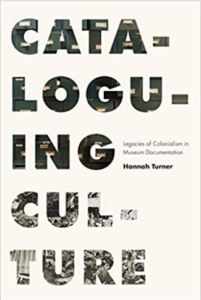Cataloguing Culture: Legacies of Colonialism in Museum Documentation, by Hannah Turner. Vancouver-Toronto: University of British Columbia Press, 2020.
Reviewed by Sarah Terheide

Museum documentation practices have had a central role in reinforcing colonialist knowledge and ideologies in collections’ records and interpretation. This may be surprising to some considering how mundane systems of documentation can appear at first glance. The book, Cataloguing Culture: Legacies of Colonialism in Museum Documentation, by Hannah Turner, explores the history of museum documentation and records keeping in museums from the late nineteenth century to the present day. Turner is a museum and information studies scholar whose research focuses on the problematic nature of museum collecting and cataloguing through an examination of the practices at the Smithsonian’s National Museum of Natural History (NMNH). Research regarding the inculcation and durability of colonial ideologies in museum practice is crucial for understanding how to decolonize museum collections and terminology.
In her book, Turner provides an enlightening analysis of how early anthropological and scientific theories shaped museum collecting and cataloguing practices. Turner’s work also demonstrates how colonial and racist ideologies created “legacy” knowledge which persists in records in the modern day. This “legacy” data was created by the initial collectors of the cultural material, and then was passed down through various documentation and accession practices within the museum. It is through this data, in some cases the only existing records concerning these objects, that racist ideologies of the mid to late nineteenth century survived until the current day. Some of the most harmful documentation practices included the classification and naming of objects with little to no input from source communities, placing authority on the knowledge of the collectors.
Turner’s summary of a collecting and cataloguing history begins with a discussion of NMNH practices in the late nineteenth century. At this time period, various museum and anthropological institutions distributed documents called “circulars.” These circulars were collecting guides to inform anyone, from amateur collectors to United States military personal, of the correct methods of recording information along with the physical collection of cultural materials. These field guides were drawn from earlier examples designed to aid in the collection of natural history collections, such as various flora and fauna. These guides had the effect of placing Native American communities in the context of the natural environment, as opposed to evaluating them as people. The circulars were also focused on collecting non-white cultural materials and bodies in order to support theories of cultural evolution. Research comparing different races and placing them in a cultural hierarchy resulted in scientific determinations of racial inferiority. Turner elaborates in this section how documentation dehumanized Native American communities. Her discussion of the history of collecting could have been strengthened by including indigenous perspectives discussing the erasure of their knowledge through these collecting and documentation practices.
Turner continues her evaluation with a discussion of how amateur collectors’ observations became the authority on the collections they donated or sold to the museum. Their notes were transcribed into museum ledgers often by volunteers or clerks who were untrained in the museum profession. The format of the ledgers themselves were also in a constant state of flux as professionals could not agree on a consistent method of labeling and organizing museum collections. The most daunting task was creating a list of terms and categories that would fit the considerable variety of objects that came into the museum. These terms changed constantly throughout museum history, and often similar objects, such as rattles, could be categorized in a multitude of ways. Turner explained that rattles, for example, could be labeled as a musical instrument or a ceremonial item. Their material could be described as a type of wood, or whatever other material that acted as a decoration or inlay. The way objects were labeled often depended on the discretion of the museum worker at the time, which created logistical problems in later locating specific artifacts.
In the early twentieth century, came the advent of card catalogue systems. Turner explains that these technologies allowed for more accessibility of collections. This was later improved upon by typewritten catalogue cards, and eventually digitization with the advent of the computer age. These evolutions in media, however, were still plagued with legacy data. Terms and information gathered by the initial collectors reflected the racist ideologies of the times. Turner concludes her book with the sentiment that museum cataloging practices require more work. Labels that were predetermined by early museum professionals are often lacking in fully describing the material culture they are meant to contextualize. Turner argues that a better system could likely be found through collaboration with North American Indigenous communities, particularly concerning naming of their cultural materials.
Turner’s book is an excellent resource which investigates the creation and maintenance of “legacy data,” and the way this data affects collections’ interpretations today. She thoroughly examines how collector observations were translated into early museum cataloguing systems at the NMNH. Turner’s book is also very efficient in demonstrating that the history of collecting and cataloguing is complex and far from infallible. The book, Cataloguing Culture, expertly communicates to the reader how knowledge was cemented in museum records. Turner’s book makes it clear to the reader that museum professionals must consult with indigenous knowledge if they are to begin the decolonization process. These types of critiques of museum practices are crucial if we are to move forward with respect to the cultures we seek to interpret.
Sarah Terheide is a graduate certificate student in the Museum Studies program at IUPUI. She also completed an MA in the Anthropology program at the University of Cincinnati with a focus on the decolonization of museum collections.

